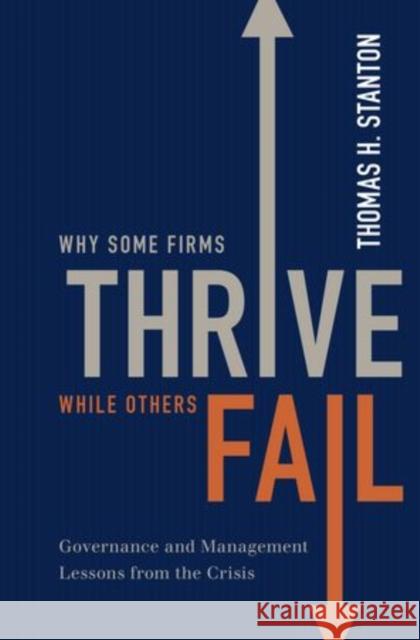Why Some Firms Thrive While Others Fail: Governance and Management Lessons from the Crisis » książka
Why Some Firms Thrive While Others Fail: Governance and Management Lessons from the Crisis
ISBN-13: 9780199915996 / Angielski / Twarda / 2012 / 292 str.
Why Some Firms Thrive While Others Fail: Governance and Management Lessons from the Crisis
ISBN-13: 9780199915996 / Angielski / Twarda / 2012 / 292 str.
(netto: 290,31 VAT: 5%)
Najniższa cena z 30 dni: 292,79
ok. 30 dni roboczych
Dostawa w 2026 r.
Darmowa dostawa!
The financial crisis revealed fundamental shortcomings in both public and private American institutions. While the firms that were successful each found their own way to weather the crisis, unsuccessful firms were remarkably alike in their inability to cope and in the mistakes they made.
Combing through the wreckage, Thomas H. Stanton examines which financial firms survived the crisis and which ones failed. He analyzes how differences in governance, organization, and management between these firms led to their success or failure, and how government supervision and regulation failed to prevent the crisis. Based on interviews that the Financial Crisis Inquiry Commission conducted with CEOs, risk officers, traders, and others at major financial firms, Stanton systematically outlines how successful firms, like JP Morgan Chase, Goldman Sachs, Wells Fargo, and others used a multitude of approaches to distinguish themselves in operational competence and intelligent discipline, while unsuccessful firms, like Fannie Mae, Freddie Mac, and Countrywide, and others uniformly failed to prepare for possible low-probability, high-impact events. Stanton concludes by issuing a call for strengthening organizational design, governance, and risk management, by identifying clear attributes that distinguish successful firms from the others. Why Some Firms Thrive While Others Fail is an invaluable resource for company officials and policymakers on the development of a risk-sensitive, more-successful culture. It also provides an essential foundation on culture and governance for students of business and public policy, practitioners within the public and private financial institutions at the center of the recent financial crisis, and those at risk of playing roles in possible future crises.Why did some firms weather the financial crisis and others not? This book builds on the author's interviews and access to internal documents from over a dozen major financial companies, investigates their workings, reveals what went wrong and discovers a remedy. A critical difference between successful and unsuccessful firms is a culture that encourages respectful challenge, what the book calls " At successful firms top management engaged in§constructive dialogue with the board, a strong management team, and the chief risk officer, among others, in making a decision; firms that failed often featured overbearing (or distracted) CEOs or unit heads, supine boards, incapable management, ineffective risk officers, and poor communications both across silos and§up the hierarchy. They often lacked ability to manage the firm as an integrated organization. §Companies need good management, and not only good risk management, to stay out of trouble. Successful companies operated with strong information systems and a culture of good communications that brought issues promptly to top management so the company could adjust its operations accordingly. Successful managers had discipline to ask simple questions and pursue answers until they understood the risk-reward tradeoffs in their activities. §Regulators too made mistakes. They didn't feel empowered to rein in companies that - at least before the crisis - seemed so profitable. Instead of waiting for a company to take losses, the book recommends that they use " as a test of good management and that supervisors require evidence that major business decisions result from a robust process rather than merely the will of a powerful CEO or heads of revenue-producing units. Companies in turn should use§their regulator as a potential source of useful feedback. The book concludes by looking at major firms in other industries and finds that its conclusions apply to these companies too.











